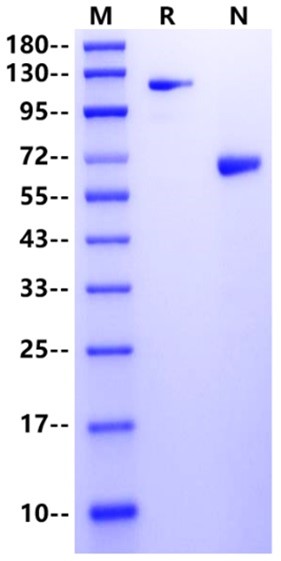Ile22-Val235, with C-terminal Human IgG1 Fc ISVETPQDVLRASQGKSVTLPCTYHTSTSSREGLIQWDKLLLTHTERVVIWPFSNKNYIHGELYKNRVSISNNAEQSDASITIDQLTMADNGTYECSVSLMSDLEGNTKSRVRLLVLVPPSKPECGIEGETIIGNNIQLTCQSKEGSPTPQYSWKRYNILNQEQPLAQPASGQPVSLKNISTDTSGYYICTSSNEEGTQFCNITVAVRSPSMNVIEGRMDPKSSDKTHTCPPCPAPELLGGPSVFLFPPKPKDTLMISRTPEVTCVVVDVSHEDPEVKFNWYVDGVEVHNAKTKPREEQYNSTYRVVSVLTVLHQDWLNGKEYKCKVSNKALPAPIEKTISKAKGQPREPQVYTLPPSRDELTKNQVSLTCLVKGFYPSDIAVEWESNGQPENNYKTTPPVLDSDGSFFLYSKLTVDKSRWQQGNVFSCSVMHEALHNHYTQKSLSLSPGK
1. Heath, J. K. , White, S. J. , Johnstone, C. N. , Catimel, B. , Simpson, R. J. , Moritz, R. L. , Tu, G. F. , et al. The human A33 antigen is a transmembrane glycoprotein and a novel member of the immunoglobulin superfamily. Proc. Natl. Acad. Sci. U. S. A. 1997. 94: 469-474.
Glycoprotein A33 (GPA33) is also known as Cell surface A33 antigen, is a single-pass type I membrane protein which is expressed in normal gastrointestinal epithelium and in 95% of colon cancers. GPA33 has high homology with CD2 and contains a V‐type Ig‐like domain at the N terminus. It is also related to proteins that have inhibitory roles in T cell activation, such as CD276 (B7‐H3) and VSIG4 and several cell adhesion molecules, such as CEACAM, ICAM, and NCAM (3D‐Protein BLAST, NCBI). Although its molecular function is not known, GPA33 has been associated with immune dysregulation. GPA33 may play a role in cell-cell recognition and signaling.

1μg (R: reducing conditions, N: non-reducing conditions).